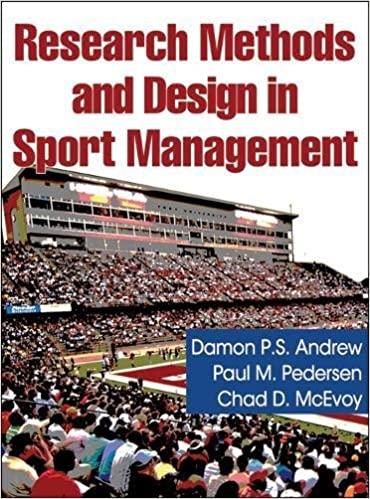Question
Summarise the characteristics of the roles of management suggested by Mintzberg. Select the correct management role for each of the characteristics listed below. CharacteristicsManagement role
Summarise the characteristics of the roles of management suggested by Mintzberg. Select the correct management role for each of the characteristics listed below.
CharacteristicsManagement roleManager acts as representative or symbol of organisation e.g. attends meetings on behalf of organisation, appears on public 'platforms' as a representative of local business.Answer
Figurehead
Leader
Liaison
Monitor
Disseminator
Spokesperson
Entrepreneur
Disturbance handler
Resource allocator
Negotiator
Emphasises the network of contacts both inside and outside organisation.Answer
Figurehead
Leader
Liaison
Monitor
Disseminator
Spokesperson
Entrepreneur
Disturbance handler
Resource allocator
Negotiator
Monitors external environment re PETS factors, e.g. competitors' activities, new legislation, market changes.Answer
Figurehead
Leader
Liaison
Monitor
Disseminator
Spokesperson
Entrepreneur
Disturbance handler
Resource allocator
Negotiator
Manager gives information to others outside organisation, e.g. in relation to organisation's policies and activities.Answer
Figurehead
Leader
Liaison
Monitor
Disseminator
Spokesperson
Entrepreneur
Disturbance handler
Resource allocator
Negotiator
Managers control some form of resources (e.g. money, time, labour).Answer
Figurehead
Leader
Liaison
Monitor
Disseminator
Spokesperson
Entrepreneur
Disturbance handler
Resource allocator
Negotiator
Intervenes in conflict situations.Answer
Figurehead
Leader
Liaison
Monitor
Disseminator
Spokesperson
Entrepreneur
Disturbance handler
Resource allocator
Negotiator
Allows manager to collect useful information, for example, manager might belong to a professional institution or body.Answer
Figurehead
Leader
Liaison
Monitor
Disseminator
Spokesperson
Entrepreneur
Disturbance handler
Resource allocator
Negotiator
Concerned with interpersonal relationships, what motivates staff and what their needs are.Answer
Figurehead
Leader
Liaison
Monitor
Disseminator
Spokesperson
Entrepreneur
Disturbance handler
Resource allocator
Negotiator
Finds solutions.Answer
Figurehead
Leader
Liaison
Monitor
Disseminator
Spokesperson
Entrepreneur
Disturbance handler
Resource allocator
Negotiator
Managers may allocate or use resources at their
discretion.Answer
Figurehead
Leader
Liaison
Monitor
Disseminator
Spokesperson
Entrepreneur
Disturbance handler
Resource allocator
Negotiator
Solves problems that arise.Answer
Figurehead
Leader
Liaison
Monitor
Disseminator
Spokesperson
Entrepreneur
Disturbance handler
Resource allocator
Negotiator
Question2
Not yet answered
Marked out of 3.00
Flag question
Question text
Tannenbaum and Schmidt identify three forces that will determine which style of leadership is appropriate in relation to the prevailing situation the organisation may face. Based on your readings of the module text, match each force with their corresponding characteristics. Select the correct force for each characteristics in the pull-down menu.
CharacteristicsForceGeneral context in which leadership activity takes place, e.g. Time available to make decision, Organisational culture and power balance, Structures and processes, PETs factors.Answer
Forces in the Manager
Forces in the Subordinate
Forces in the Situation
Subordinates vary in their characteristics such as degree of support needed, experience / knowledge of work, commitment to organisational goals, expectations as to how leaders will behave, previous experience of different leadership styles.Answer
Forces in the Manager
Forces in the Subordinate
Forces in the Situation
Each manager has his or her own combination of personality characteristics, skills and knowledge, values and attitudes which predisposes the adoption of one particular style of leadership or another.Answer
Forces in the Manager
Forces in the Subordinate
Forces in the Situation
Question3
Not yet answered
Marked out of 40.00
Flag question
Question text
Summarise the forces that will either promote or impede organisational change. Select the correct driving forces that correspond to the appropriate facts from the pull-down menu.
CharacteristicsDriving forcesSocial pressuresAnswer
External forces
Internal forces
Individual resistance
Organisational resistance
Answer
for change
against change
Role of the stateAnswer
External forces
Internal forces
Individual resistance
Organisational resistance
Answer
for change
against change
Dislike of the uncertainty and
ambiguity surrounding changeAnswer
External forces
Internal forces
Individual resistance
Organisational resistance
Answer
for change
against change
Customer needsAnswer
External forces
Internal forces
Individual resistance
Organisational resistance
Answer
for change
against change
Changing technologyAnswer
External forces
Internal forces
Individual resistance
Organisational resistance
Answer
for change
against change
Potential loss of rewardsAnswer
External forces
Internal forces
Individual resistance
Organisational resistance
Answer
for change
against change
Organisational growthAnswer
External forces
Internal forces
Individual resistance
Organisational resistance
Answer
for change
against change
Pressures for increased
performanceAnswer
External forces
Internal forces
Individual resistance
Organisational resistance
Answer
for change
against change
Managerial aspirationsAnswer
External forces
Internal forces
Individual resistance
Organisational resistance
Answer
for change
against change
Fear of the unknownAnswer
External forces
Internal forces
Individual resistance
Organisational resistance
Answer
for change
against change
Potential loss of current skillsAnswer
External forces
Internal forces
Individual resistance
Organisational resistance
Answer
for change
against change
Constraints from suppliersAnswer
External forces
Internal forces
Individual resistance
Organisational resistance
Answer
for change
against change
Political coalitionsAnswer
External forces
Internal forces
Individual resistance
Organisational resistance
Answer
for change
against change
Redesign of jobsAnswer
External forces
Internal forces
Individual resistance
Organisational resistance
Answer
for change
against change
Inertial forces deriving from the systemic nature of organisationsAnswer
External forces
Internal forces
Individual resistance
Organisational resistance
Answer
for change
against change
Stakeholder demandsAnswer
External forces
Internal forces
Individual resistance
Organisational resistance
Answer
for change
against change
Inertial forces deriving from group normsAnswer
External forces
Internal forces
Individual resistance
Organisational resistance
Answer
for change
against change
Lack of organisational capabilityAnswer
External forces
Internal forces
Individual resistance
Organisational resistance
Answer
for change
against change
Threat to resource allocationAnswer
External forces
Internal forces
Individual resistance
Organisational resistance
Answer
for change
against change
Potential loss of group power basesAnswer
Step by Step Solution
There are 3 Steps involved in it
Step: 1

Get Instant Access to Expert-Tailored Solutions
See step-by-step solutions with expert insights and AI powered tools for academic success
Step: 2

Step: 3

Ace Your Homework with AI
Get the answers you need in no time with our AI-driven, step-by-step assistance
Get Started


